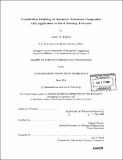Constitutive modeling of advanced thermoset composites with application to sheet forming processes
Author(s)
Kofoid, Jamie N. (Jamie Nelson), 1977-
DownloadFull printable version (19.56Mb)
Other Contributors
Massachusetts Institute of Technology. Dept. of Mechanical Engineering.
Advisor
Simona Socrate.
Terms of use
Metadata
Show full item recordAbstract
Advanced thermoset composites are an important class of materials employed primarily in aerospace applications that consist of a thermoset polymer resin matrix that is reinforced by systematically arranged, continuous graphite fibers. Composite sheet forming, or thermoforming, is a process where flat sheets of composite layups are heated and formed into desired part shapes. Due to the complex nature of composite material response, successful composite sheet forming processes (that avoid defects such as fiber wrinkling) are traditionally the result of costly trial-and-error methods. The main objective of this research is to develop constitutive material models that can be utilized for modeling thermoset composite response during sheet forming processes. A continuum model has been developed that accounts for temperature and rate dependencies and allows solid finite element modeling that tracks material response on the microscopic level, including fiber wrinkling. The second model is a simplified, transversely isotropic elastic-plastic model that can be used together with a finite element model which employs structural (shell) elements to monitor macroscopic material response in a less computationally-intensive manner. The constitutive parameters of both models were optimized to match observed material behavior from unidirectional tensile and bending tests conducted on the composite at various temperatures and strain rates. The models were tested against a series of three-point bending verification tests that were conducted on quasi-isotropic composite layups at various rates and temperatures. Also included is an investigation of various finite element approaches that can be employed using these models to simulate (cont.) forming processes. The completed continuum model satisfactorily captures most composite behavior, with the exception of transverse shear flow behavior along the fibers. The model, developed using the assumption of isotropic flow response, requires greater refinement in order to more accurately capture composite behavior. The completed transversely isotropic elastic-plastic model satisfactorily captures all modes of composite behavior observed during experimentation. The simplified nature of this model, however, limits it from accurately describing behaviors such as fiber wrinkling during deformation.
Description
Thesis (S.M.)--Massachusetts Institute of Technology, Dept. of Mechanical Engineering, 2004. Includes bibliographical references (leaves 164-169).
Date issued
2004Department
Massachusetts Institute of Technology. Department of Mechanical EngineeringPublisher
Massachusetts Institute of Technology
Keywords
Mechanical Engineering.